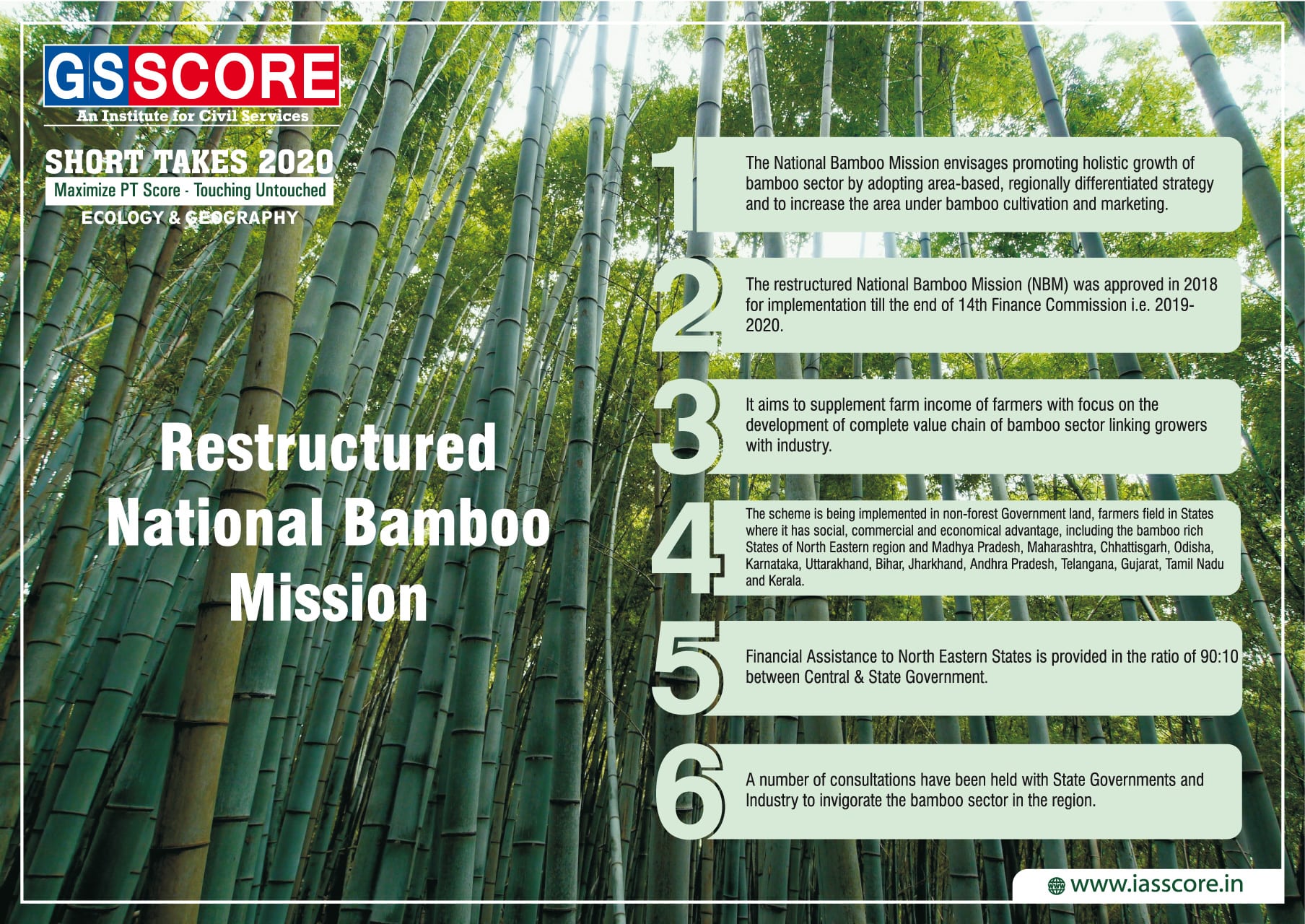Environment & Ecology: Recent Development Part - 2
Recent Development
1. YAMUNA ACTION PLAN
River Yamuna is one of the major rivers in India and also a major tributary to India’s largest river - river Ganges.
Riverine water resources, including river Yamuna, are increasingly becoming vulnerable to quantity decline and quality degradation due to human activities, the modified flow regime due to water holding structures or barrages, withdrawal of water for irrigation & drinking purposes and the cumulative discharge of domestic, industrial & agricultural wastewaters has converted the Yamuna into almost an open sewer in the stretch of Delhi and Agra. As a result, the river is impacting the bio-diversity of the ecosystem and endangering public health of the inhabitants. The prevalence of poor sanitation practices also contributes to the proliferation of a number of diseases and an adverse living environment.
Yamuna Action Plan I and II
- In 1977-78, CPCB initiated a study to assess the status of pollution of Yamuna River over its 1200 km course. The study examined the topography of the drainage basin, base flow, population, land use pattern, industries, and agriculture practices and estimated the pollution load from activities in the basin. Study conducted by the CPCB indicated that the major cause of pollution is the discharge of domestic wastewater into the river which is about two-third of the pollution load. The remaining pollution is contributed by industries and agriculture. Based on the findings of this study, the Government of India (GoI) decided to take up water quality restoration measures named as Yamuna Action Plan (YAP) under the mega project of the Ganga Action Plan (GAP) phase–II. The Government of Japan provided loan assistance for implementation of YAP in December-1990. YAP was formally launched in 1993, now called as YAP phase I (YAP I). The main activities covered under YAP were interception and diversion works, pumping stations, STPs, low cost toilet complex, crematorium, plantation, bathing ghat / river front development, public participation and awareness and computer networking system. The limitation of YAP I were:
- The STP capacity created remained under-utilised to the extent of 25-45% because of severe limitations in the collection system and power availability.
- The strategy in YAP-I did not adequately address non-point sources.
- Municipalities and agencies which were responsible for Operation & Maintenance (O&M) of sewerage infrastructure were constrained to maximize the operational efficiency of the system due to a combination of factors related to skills, finance, management systems, power cuts and upstream sewerage infrastructure.
- Subsequently, the work continued with the launch of YAP phase II (YAP II) in the year 2004 with the sanctioned cost of 647 crores. The project was completed in 2008 Under YAP II, emphasis was on the 22-km stretch of Yamuna in Delhi. The Yamuna Action Plan Project Phase II is regarded as the core project under the National River Conservation Plan of Government of India. The project addresses the abatement of severe pollution of the River Yamuna by raising sewage treatment capacity, caused by rapid population growth, industrialization and urbanization.
- The plan includes building new and expanding capacity of old sewage treatment plants and laying and rehabilitating sewers to enhance the treatment capacity particularly in Delhi and Agra. Public participation and awareness were also a part of project to ensure the residents' recognition of the necessity of water quality conservation in the River Yamuna, and would establish linkage between the river conservation and their own living environments. But, there had been no concrete results even though Rs.1, 500 crore had been spent through phases one and two of the Yamuna Action Plan. It has been observed that despite of the continuous efforts to minimize the pollution load still the BOD is not decreasing.
- The Yamuna Action Plan Phase - III project for Delhi has been approved by the Ministry in December, 2011 at an estimated cost of Rs 1656 crore with loan assistance from Japan International Cooperation Agency. Besides this, two projects have also been sanctioned by the Ministry in July, 2012 at an estimated cost of Rs. 217.87 crore for taking up works for pollution abatement of river Yamuna in towns of Sonepat and Panipat in Haryana which are located on upstream of Wazirabad in Delhi.
NGT rules related to Yamuna
- As a consequence of present deplorable state of the river, NGT has given directions to take up cleaning of Yamuna under Maily Se Nirmal Yamuna Revitalization Plan, 2017.
- In pursuance of this direction, the Centre and the Delhi government have come together to launch projects under phase three of the Yamuna Action Plan .
- This Yamuna Action Plan-3 will be the first plan to comprehensively help with sewage treatment and solid waste management along with river front development and providing a proper Chhat Ghat for devotees.
- National Green Tribunal (NGT) ordered that every household in Delhi will have to pay a monthly environmental compensation to clean up Yamuna River.
- According to the direction, the compensation to be paid will be directly proportional to the property or water tax whichever is higher, paid by a particular household. In case of unauthorized colonies households that do not pay property tax or water bill will have to pay an amount that would be between 100 rupees to 500 rupees.
- According to the Tribunal, industrial units within a particular industrial cluster have to pay these amounts on the ‘Polluter Pays’ Principle, for the pollution already caused by them and even which they are causing presently, as well as to prevent pollution in future on the Precautionary Principle. Major part of such costs, obviously have to be borne by the authorities concerned, let us say 2/3rd, while 1/3rd of the total costs should be borne by the industries.
Way forward
- Effective coordination between State and Central government agencies is required in terms of execution
- It is necessary to reduce the quantity of water being drawn from the river for irrigation. Efficient irrigation methods like sprinklers or drip method should be used.
- Effective check to ensure in situ treatment of effluents is done before discharge from industries.
- Steps must be taken to relocate the existing settlements and encroachments near the floodplains and no further encroachments should be allowed.
- There should be a ban on construction of new barrages
- Since there is shortage of landfill sites in Delhi, most wastes are dumped in the river. Keeping this in mind, immediate action needs to be taken to identify more landfill sites in Delhi.
- Public awareness is most important prevention measure. Effective steps should be taken to enhance public awareness.
2. National Water Mission
- The National Action Plan on Climate Change (NAPCC) describes the features of National Water Mission as under: “A National Water Mission will be mounted to ensure integrated water resource management helping to conserve water, minimize wastage and ensure more equitable distribution both across and within states.”
- The Mission will take into account the provisions of the National Water Policy and develop a framework to optimize water use by increasing water use efficiency by 20% through regulatory mechanisms with differential entitlements and pricing.
- It will seek to ensure that a considerable share of the water needs of urban areas are met through recycling of waste water, and ensuring that the water requirements of coastal cities with inadequate alternative sources of water are met through adoption of new and appropriate technologies such as low temperature desalination technologies that allow for the use of ocean water.
- The National Water Policy would be revisited in consultation with States to ensure basin level management strategies to deal with variability in rainfall and river flows due to climate change.
- This will include enhanced storage both above and below ground, rainwater harvesting, coupled with equitable and efficient management structures.
- The Mission will seek to develop new regulatory structures, combined with appropriate entitlements and pricing. It will seek to optimize the efficiency of existing irrigation systems, including rehabilitation of systems that have been run down and also expand irrigation, where feasible, with a special effort to increase storage capacity. Incentive structures will be designed to promote water-neutral or water- positive technologies, recharging of underground water sources and adoption of large scale irrigation programmes which rely on sprinklers, drip irrigation and ridge and furrow irrigation.”
- Each Mission will be tasked to evolve specific objectives spanning the remaining years of the 11th Plan and the 12th Plan period 2012-2013 to 2016-2017. Where the resource requirements of the Mission call for an enhancement of the allocation in the 11th Plan, this will be suitably considered, keeping in mind the overall resources position and the scope for re-prioritization".
- Building public awareness will be vital in supporting implementation of the NAPCC. This will be achieved through national portals, media engagement, civil society involvement, curricula reform and recognition / awards, details of which will be worked out by an empowered group. The Group will also consider methods of capacity building to support the goals of the National Missions.
- The appropriate technologies will be developed to measure progress in actions being taken in terms of avoided emissions, wherever applicable, with reference to business as usual scenarios. Appropriate indicators will be evolved for assessing adaptation benefits of the actions.
- These Eight National Missions taken together, with enhancements in current and ongoing programmes included in the Technical Document, would not only assist the country to adapt to climate change, but also, importantly, launch the economy on a path that would progressively and substantially result in mitigation through avoided emissions.” The ‘Technical Document’ annexed with the NAPCC has identified key areas related to:
- Studies on management of surface water resources,
- Management and regulation of ground water resources,
- Upgrading storage structures for fresh and drainage system for wastewater,
- Conservation of wetland, and
- Development of desalination technologies etc. required to be considered while preparing the comprehensive document for the National Water Mission.
-
NWM has identified five goals as under:
- Comprehensive water data base in public domain and assessment of the impact of climate change on water resource,
- Promotion of citizen and state actions for water conservation, augmentation and preservation,
- Focused attention to vulnerable areas including over-exploited areas,
- Increasing water use efficiency by 20%, and
- Promotion of basin level integrated water resources management.
3. SECURE Himalaya
- The Government of India and United Nations Development Programme, with support from the Global Environment Facility, are implementing a new programme in the high altitude Himalayas entitled “SECURE Himalayas - Securing livelihoods, conservation, sustainable use and restoration of high range Himalayan ecosystems”, to ensure conservation of locally and globally significant biodiversity, land and forest resources in the high Himalayan ecosystem, while enhancing the lives and livelihoods of local communities.
Key Components
- Conservation of key biodiversity areas and their effective management to secure long-term ecosystem resilience, habitat connectivity and conservation of snow leopard and other endangered species and their habitats
- Securing sustainable community livelihoods and natural resource management in high range Himalayan ecosystems
- Enhancing enforcement, monitoring and cooperation to reduce wildlife crime and related threats
- Knowledge, advocacy, communication and information systems established
4. World Sparrow Day
- World Sparrow Day is a day designated to raise awareness of the house sparrow and then other common birds to urban environments, and of threats to their populations, observed on 20 March.
- It is an international initiative by the Nature Forever Society of India in collaboration with the Eco-Sys Action Foundation (France) and numerous other national and international organisations across the world.
- The Nature Forever Society was started by Mohammed Dilawar, an Indian conservationist who started his work helping the house sparrow in Nashik, and who was named one of the "Heroes of the Environment" for 2008 by Time for his efforts.
- The idea of marking World Sparrow Day came up during an informal discussion at the Nature Forever Society's office.
- The idea was to earmark a day for the house sparrow to convey the message of conservation of the house sparrow and other common birds and also mark a day of celebration to appreciate the beauty of the common biodiversity which is taken so much for granted.
- The first World Sparrow Day was celebrated in 2010 in different parts of the world.
- The day was celebrated by carrying out different various kinds of activities and events like art competitions, awareness campaigns, and sparrow processions as well as interactions with media.
- World Sparrow Day also has a broader vision to provide a platform where people who are working on the conservation of the house sparrow and other common birds can network, collaborate and exchange conservation ideas which will lead to better science and improved results.
- It aims to provide a meeting ground for people from different parts of the world to come together and form a force that can play an important role in advocacy and in spreading the awareness on the need of conserving common biodiversity or species of lower conservation status.
5. Land Degradation Neutrality (LDN)
- Desertification is threatening the livelihoods of 1 billion people in over 100 countries, and each year 12 million hectares of arable land are lost to drought. The extent and severity of land degradation worldwide, combined with the negative effects of climate change, population growth and an ever-increasing demand for natural resources, requires immediate and assertive action. The economic costs of desertification and land degradation are estimated at USD 490 billion per year. Avoiding land degradation through sustainable land management can generate up to USD 1.4 trillion of economic benefits.
- Policies and programmes to halt and reverse land degradation have long suffered from the absence of a clear overarching goal and quantitative, time-bound targets to guide action and make measurable progress. In October 2015, UNCCD country Parties reached a breakthrough agreement on the land degradation neutrality (LDN) concept.
- The LDN concept has been developed to encourage implementation of an optimal mix of measures designed to avoid, reduce and/or reverse land degradation in order to achieve a state of no net loss of healthy and productive land. LDN aims to balance anticipated losses in land-based natural capital and associated ecosystem functions and services with measures that produce alternative gains through approaches such as land restoration and sustainable land management.
- LDN is a simple idea and a powerful tool. It means securing enough healthy and productive natural resources by avoiding degradation whenever possible and restoring land that has already been degraded. At its core are better land management practices and better land use planning that will improve economic, social and ecological sustainability for present and future generations.
- Numerous direct links exist between LDN and Sustainable Development Goals (SDG), such as eradicating poverty, ensuring food security, protecting the environment and using natural resources sustainably. LDN serves as a catalyst in achieving these goals.
LDN and climate change
- LDN provides significant benefits in terms of mitigation and adaptation to climate change. Halting and reversing land degradation can transform land from being a source of greenhouse gas emissions to a carbon sink, by increasing carbon stocks in soils and vegetation. Furthermore, LDN plays a key role in strengthening the resilience of rural communities against climate shocks by securing and improving the provision of vital ecosystem services.
- These links between land and climate are reflected in the Intended Nationally Determined Contributions (INDCs) submitted by countries to COP 21 of the UN Framework Convention on Climate Change (UNFCCC) in Paris in 2015. More than 100 of the INDCs included land-based activities for mitigation and adaptation. LDN targets and associated measures contribute to and depend on the implementation of national climate plans and vice versa. Such synergies should be taken into account when developing national plans for LDN and revising and updating the INDCs under the Paris Agreement.
6. Forest-PLUS 2.0
- US Agency for International Development (USAID) and India's Ministry of Environment, Forest and Climate Change (MoEF&CC) officially launched Forest-PLUS 2.0 on September 25, 2019.
- It is a five-year programme initiated in December 2018 that focuses on developing tools and techniques to bolster ecosystem management and harnessing ecosystem services in forest landscape management.
- Tetra Tech ARD, a consulting and engineering company headquartered in the US, was given the contract to implement the programme and IORA Ecological Solutions, a New Delhi-based environmental advisory group, is its implementation partner.
- Forest-PLUS 2.0, the second set of pilot projects, is meant to enhance sustainable forest landscape management after Forest-PLUS completed its five years in 2017.
- The programme’s first set focused on capacity building to help India participate in Reducing Emissions from Deforestation and forest Degradation (REDD+). It included four pilot projects in Sikkim, Rampur, Shivamogga and Hoshangabad.
- Under these, field tests, innovative tools and approaches for Indian forest management were developed. Promotion of bio-briquettes in Sikkim, introduction of solar heating systems in Rampur and development of an agro-forestry model in Hoshangabad were some of the achievements of this programme.
- Forest-PLUS 2.0 comprises pilot project in three landscapes — Gaya in Bihar, Thiruvananthapuram in Kerala and Medak in Telangana. The choice of these sites was driven by the contrast in their landscapes – Bihar is a forest deficit area, Telangana is a relatively drier area where there is ample scope for community livelihood enhancement and Kerala is rich in biodiversity.
The targets of this set are –
-
- 1,20,000 hectares of land under improved management
- New, inclusive economic activity worth $12 million
- Measurable benefits accrued to 800,000 households
- Three incentive mechanisms demonstrated in managing landscapes for ecosystem services
To achieve these targets, the programme has three focal points of action –
-
- Developing tools for multiple services in forests management. The tools consists of innovative apps for automating forest planning processes, model forest management plans. These tools are expected to result in enhanced water flow and quality, improved livelihoods and resilience of forest-dependent communities.
- Developing incentive-based instruments for leveraging finance. For example, a payment mechanism where a municipality or industry would pay upstream forest communities to use water flowing down because of improved forest management.
- Unlocking economic opportunities for forest-dependent people by modelling and setting up conservation enterprises and mobilising investment from the private sector.
Important International Events to Protect Environment
Earth Day
- The Earth Day is an annual event celebrated across the world on April 22. Its celebration is coordinated globally by the Earth Day Network.
- In 1969, at a UNESCO Conference in San Francisco, the peace activist John McConnell proposed a day to honour Earth and the concept of peace, the first to be celebrated on 21st March 1970, the first day of spring in the Northern Hemisphere.
Earth Hour
- The Earth Hour is a worldwide movement organized by the WWF. The event is held annually, encouraging individuals, communities, households and businesses to turn off their non-essential lights for one hour, from 8:30 to 9:30 p.m., as a symbol for their commitment to the planet. It was started as a lights-off event in Sydney, Australia, in 2007. Since then, it has grown to engage more than 7,000 cities and towns across 172 countries worldwide. Every year, the event begins at Sydney’s Opera House and Bridge, Australia.
International Day of Biological Diversity
- The United Nations has proclaimed May 22 as the International Day for Biological Diversity (IDB) to increase understanding and awareness of biodiversity issues. The UN General Assembly adopted May 22 as IDB, to commemorate the adoption of the Convention on Biological Diversity. Earlier, IDB was celebrated on December 29, each year. The IDB was changed because it was difficult for many countries to plan and carry out suitable celebrations on December 29, given the number of holidays that coincide around that time of the year.
World Environment Day
- The World Environment Day (WED) that falls on June 5 every year, is the United Nation’s principal vehicle for encouraging worldwide awareness and action for the protection of our environment.
- First held in 1974, the WED has grown to become a global platform. The WED was designated by the UN General Assembly in 1972 on the first day of United Nations Conference on the Human Environment.
- Two years later, in 1974 the first WED was held with the theme ‘Only One Earth’. Each year, WED has a new theme.
International Day for the Preservation of the Ozone Layer
- In 1994, the UN General Assembly proclaimed September 16 as the International Day for the preservation of the ozone layer, commemorating the date of the signing, in 1987, of the Montreal Protocol on substances that deplete the ozone layer.
International Day of Forests
- The International Day of Forests was established on March 21, by the resolution of the United Nations General Assembly in 2012. Each year, various events celebrate and raise awareness of the importance of all types of forests and trees outside forests, for the benefit of current and future generations. The Secretariat of the United Nations Forum on Forests, in collaboration with the Food and Agriculture Organization, facilitates the implementation of such events in collaboration with governments and various organizations. International Day of Forests was observed for the first time on 21st March 2013.
World Habitat Day
- World Habitat Day is observed every year on the first Monday of October throughout the world. It was officially designated by the United Nations and first celebrated in 1986.
Proposal to amend the Disaster Management Act of 2005
Context
Union Cabinet is taking up the proposal to amend the Disaster Management Act of 2005.
About
- The present Act largely focuses on
- Improving preparedness
- Providing immediate relief
- Protecting infrastructure
- The main drawback of the present policy is it neglects long-term recovery.
A brief about disaster management act, 2005
- It was enacted to effectively prevent, mitigate (reducing the severity) and prepare for disasters.
- It came into being on the heels of three major disasters.
- 1999 - Super cyclone in Odisha
- 2001 - Bhuj earthquake
- 2004 - Indian Ocean tsunami.
- The Act mandated the creation of the National Disaster Management Authority, State Disaster Management Authorities and District Disaster Management Authorities.
- It laid down the framework, roles and responsibilities of these bodies to formulate and implement disaster management plans at their levels.
The focus of the act is preparedness, that is:
- Most States invested in resilient infrastructure, early warning systems and evacuation.
- This translated into
- timely warnings
- relief shelters and
- massive evacuation exercises
- All these steps have reduced casualties.
- NDRF and SDRF have helped in providing immediate relief in the aftermath of dis
Long-term recovery
- Once the hazardous situation is passed, the important aspect is how to ensure recovery.
- We are seeing disasters from the narrow prism of providing food, water and medicines.
- At the most, some states are looking at providing shelter.
- These interventions are crucial, but long-term recovery needs much more.
What is urgently needed?
- Recovery measures should address inherent vulnerabilities pertaining to livelihoods, education, water, sanitation, health, and ecology of the disaster-affected communities.
- Intangible losses such as psychosocial needs of the communities should be given equal emphasis.
- Long-term recovery needs to be thought of alongside development in an integrated comprehensive manner by combining health, skill building and livelihood diversification schemes.
- This would ensure that communities have, at the very least, recovered to a new normal before the next disaster strikes. This understanding is crucial to the lawmakers looking to amend the Act.
Cryodrakon Boreas
Context
Cryodrakon boreas, the largest flying animal was a plane-sized reptile
About
- New species of pterosaur, the plane-sized reptiles that lorded over primeval skies above T-rex, Triceratops and other dinosaurs of the late Cretaceous.
- With a wingspan of 10 m and weighing 250 kg, Cryodrakon boreas rivals another pterosaur as the largest flying animal of all time
- Its remains were first discovered more than 30 years ago in Alberta, Canada, yet elicited scant excitement because of the misclassification.
- Like other winged reptiles living at the same time, about 77 million years ago, boreas was carnivorous and probably fed on lizards, small mammals and even baby dinosaurs.
- Despite their large size and wide distribution across North and South America, Asia, Africa and Europe only fragmentary remains have been unearthed, making the new find especially important.
Deforestation, agriculture triggered soil erosion 4,000 years ago
Context
Increased sediment deposits and changes in land use showed the degradation of soil during the last four millennia. Human activities such as agriculture and deforestation intensified global soil erosion 4,000 years ago, according to a study.
About
- While weathering of soil and erosion has, known to be controlled by changing climatic patterns and tectonic impacts of the planet, the new study suggests a role of human practices and land use-change.
- Soil erosion has direct impacts on climate and society, as it decreases the productivity of ecosystems and changes nutrient cycles.
- Max Planck Institute, a Germany-based non-profit, used radiocarbon dating techniques recorded temporal changes of soil erosion by analysing sediment deposits in more than 600 lakes worldwide. To understand the cause they analysed pollen fossil records and observed a decline in the tree cover.
- Changes in land cover were identified as the main driver of soil erosion in 70 per cent of all studied watersheds. This suggests that human practices intensified soil erosion much before the advent of industrialisation.
- Socio-economic developments during human settlements also correlated with sediment accumulation in lakes, a proxy for soil erosion.
Wetlands in Kashmir shrinking due to urbanisation
- An analysis of land cover data shows that the catchment of Narkara wetland in near Srinagar is now predominantly an urban setting.
- Wetlands are an integral part of the fragile ecosystem in north-western Himalaya. Jammu and Kashmir has several wetlands but those located close to urban areas are showing signs of deterioration due to land use change.
- This reduction is attributed to barren lands and agriculture being taken over by built-up area.
- The reckless urbanisation both within Narkara and its catchment not only affects the hydrology and ecology of this important semi-urban wetland but also increases vulnerability of people to flooding in this part of Himalaya because wetlands act as natural sponges and flood protection system.
- The gradual squeezing of wetlands is affecting their buffering capacity to withhold flood waters and storm water runoff.
- The catchment of Narkara is predominantly a semi-urban setting with settlements, agricultural fields and table lands locally called karewas, which are barren denuded landscapes. The wetland is a breeding ground for water fowl species that migrate from Russia and Central Asia during winters.
Gogabeel: Bihar’s First Community Reserve

Odishas effort to conserve Gharial

Andaman and Nicobar get Island Protection Zone (IPZ)

Goa Introduces Tags to Protect Biodiversity Zones

Restructured National Bamboo Mission



